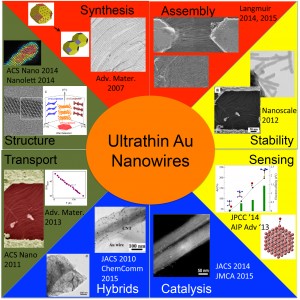GOING FOR GOLD
Using advanced microscopy techniques like transmission electron microscopy, N Ravishankar and his team study nanostructures, especially how they form, grow and attain specific shapes.
Ravishankar has a special interest in “growing” nanowires, one-dimensional wires which promise to revolutionize many fields. His group was the first in the world to grow ultrathin gold nanowires which are no more than five or six atoms thick—single crystals without high angle boundaries. The wires have a diameter of less than two nanometres (by contrast, a sheet of paper in your notebook is more than 100,000 nm thick). Explaining why growing these ultrathin gold nanowires was exciting, Ravishankar says, “Gold is as simple a system as one can imagine: it has a cubic structure; it is a noble and pure metal with excellent electrical conductivity; and it has high symmetry, with no unique direction to grow along. However in the nanowire form, most of these attributes are changed dramatically.”
 The process was, however, not easy. Ravishankar says that they had to trick the system into growing along a specific direction. But once he and his team identified a way of achieving this, they discovered several new and unexpected features of these wires, thus contributing towards a new understanding of one-dimensional nanostructures.
The process was, however, not easy. Ravishankar says that they had to trick the system into growing along a specific direction. But once he and his team identified a way of achieving this, they discovered several new and unexpected features of these wires, thus contributing towards a new understanding of one-dimensional nanostructures.
Ravishankar points out that though his lab’s research on these nanowires is primarily fundamental in nature, it is finding many applications. “The results and understanding that we obtain are generic in nature, and can be used for many applications,” he adds.One such application, described in a new study, is the use of gold nanowires as reaction catalysts for cells which use non-renewable fuels.*
One such application, described in a new study, is the use of gold nanowires as reaction catalysts for cells which use non-renewable fuels
The study details the performance of these wires and their hybrids using techniques such as cyclic voltammetry and electrochemical impedance spectroscopy. The results reveal that these nanowires outshine bulk gold which suffers from the problem of aggregation and is therefore responsible for low efficiency of fuel cells.
* A Leelavathi, R Ahmad, AK Singh, G Madras and B Ravishankar. 2015. Graphene-oxide-supported ultrathin Au nanowires: efficient electrocatalysts for borohydride oxidation. Chem. Communication.51:16856-16859




 The process was, however, not easy. Ravishankar says that they had to trick the system into growing along a specific direction. But once he and his team identified a way of achieving this, they discovered several new and unexpected features of these wires, thus contributing towards a new understanding of one-dimensional nanostructures.
The process was, however, not easy. Ravishankar says that they had to trick the system into growing along a specific direction. But once he and his team identified a way of achieving this, they discovered several new and unexpected features of these wires, thus contributing towards a new understanding of one-dimensional nanostructures.